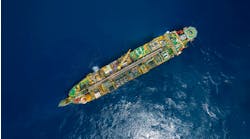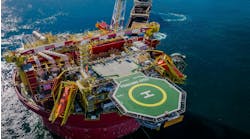SEISMIC ACQUISITION Single-source multi-streamer producing high fold at a lower cost
New generation of vessels making cost-effective high fold surveys possible for frontier areas, mature fields, and difficult structures
Dev George
Managing Editor
International
- A single-source, octa-streamer shoot achieves the same eight CMP lines that a dual-source, quad-streamer shoot does, but without the problems inherent in multi-source acquisition.
The remarkable recent revolution in seismic vessels and their capabilities is just beginning to impact the offshore petroleum industry. High tech 3D seismic acquisition has become the survey of choice for all but the simplest structures and unexplored areas. To achieve this level of data acquisition, surveys have been progressively augmented.
"First we used single-source, single-streamer acquisition," said Dave Howe, geophysicist at British Petroleum in Aberdeen, "then we progressed to a dual source and single streamer, which gave us two lines at a time, but with half the number of source points on each line. After that, we went to single-source, dual-streamer, then we stretched to dual-source, dual-streamer, then on to dual-source triple-streamer, and dual-source quadruple-streamer. Now, we're going back to single-source with multiple streamers. Essentially, our goal is to have as high a fold data as we can get as cheaply as we can get it, and these have been steps on that road."
Single-source, multiple-streamer acquisition achieves that goal, but it is not a new geophysical technology. Rather, it is a result of improvements in the engineering of seismic vessels and their streamer capacity.
"We could always go and get single-source high-fold data by shooting with a single streamer and single source," said Howe, "It would take forever and would be very expensive, but we could have done it before. With the latest design of vessels, however, we are able to get that high fold data much more cost effectively."
Single-source shoots
BP has actually been doing single-source multi-streamer surveys for several years. In 1989, it commissioned Geco-Prakla to shoot one over the Claire Field, because it was a very deep target in quite a difficult frontier area west of the Shetland Islands. The company wanted to maximize penetration and make sure they had the best signal-to-noise ratio possible. Since then, BP has had two additional single-source surveys shot over existing fields in the North Sea within the past two years. Amerada Hess has also had a single-source survey shot west of Shetlands, which had triple streamers. Total wanted to do the same, but, according to sources, couldn't get partner approval for the extra cost.
Now, Shell Expro has contracted to be the first to employ PGS's new generation seismic vessel, the Ramform Explorer, to conduct a high-fold multi-streamer shoot of its Brent Field.
Small but valuable difference
The difference between single-source and dual-source is very small, but in certain areas where the structures are complex, where there are high noise levels, and where there are difficult multiple problems, very valuable. In those kinds of areas, "It's a struggle to get data of adequate quality to meet our business needs," says Howe. "In those cases, we'd be prepared to pay twice as much to get a single-source data with the higher fold. In the past the cost has been a factor of two. When you had two sources firing alternatively, you got half the fold but twice the number of lines covered, twice the area covered. With the multi-streamer single-source capability, you're now bringing that higher quality data into play for less cost, so its quite attractive, but still it is only required in certain areas."
Single-source acquisition with multiple streamers is particularly applicable in the North Sea and Gulf of Mexico, where the lives of mature fields can often be extended through high fold 3D seismic delineation for maximum hydrocarbon recovery.
According to Howe, the North Sea also is a good candidate for single-source surveys because of multiple problems "where we frequently don't have a strong reflector from our target, we have a problem of multiples overlying that target, and the objective is to get rid of the multiple very efficiently so we can see the weaker reflection data underneath."
The Ramform Explorer
PGS's new configuration vessel, the Ramform Explorer will be employed by Shell Expro to shoot a single-source, octa-streamer survey of the North Sea's Brent Field.
Chris Walker, Geophysical Manager, PGS UK, says this is precisely why Shell has chosen to do a single-source multi-streamer shoot of the Brent Field. "Shell is trying to improve their resolution on the Brent Field. It's got about another five years left as an oil producer, and then they're going to switch over to extract the gas from the reservoir. That's why we'll be shooting what Shell calls a high density 3D there as the Ramform's first job. It's a single-source, eight-streamer operation, where we'll end up with 18 3/4 meter cross-line spacing to achieve 72-fold data."
There is a general trend away from going to a large number of sources, according to Walker, and it's been increasing considerably in the North Sea, where companies have encountered numerous imaging problems with dual sources or quad-quad operations that were used a few years ago. Such operations are limited by the physical constraints on the vessel and the recording time, because of the propagation of velocity in the earth, meaning that the sources can only be fired every 50 meters - a fairly large shot spacing on any given CMP, which causes some problems in processing. Additionally, aliasing of DMO operators occurs, and this results in a degraded image because of having more than one source.
"Shell is going out with single-source to get the maximum possible resolution and very tight line spaces at Brent," Walker says. "They had a 2D survey that had better resolution than the 3D data they'd recently acquired. This was partly due to positioning errors in the 3D, but part of it was simply the fact that data are higher fold when shot in 2D. Thus their decision to go with the Ramform. The cost would have been almost double the cost of a traditional 3D shoot, if it were to have the same number of streamers, but by using eight streamers, we can make full fold acquisition at a much lower cost."
Copyright 1995 Offshore. All Rights Reserved.




